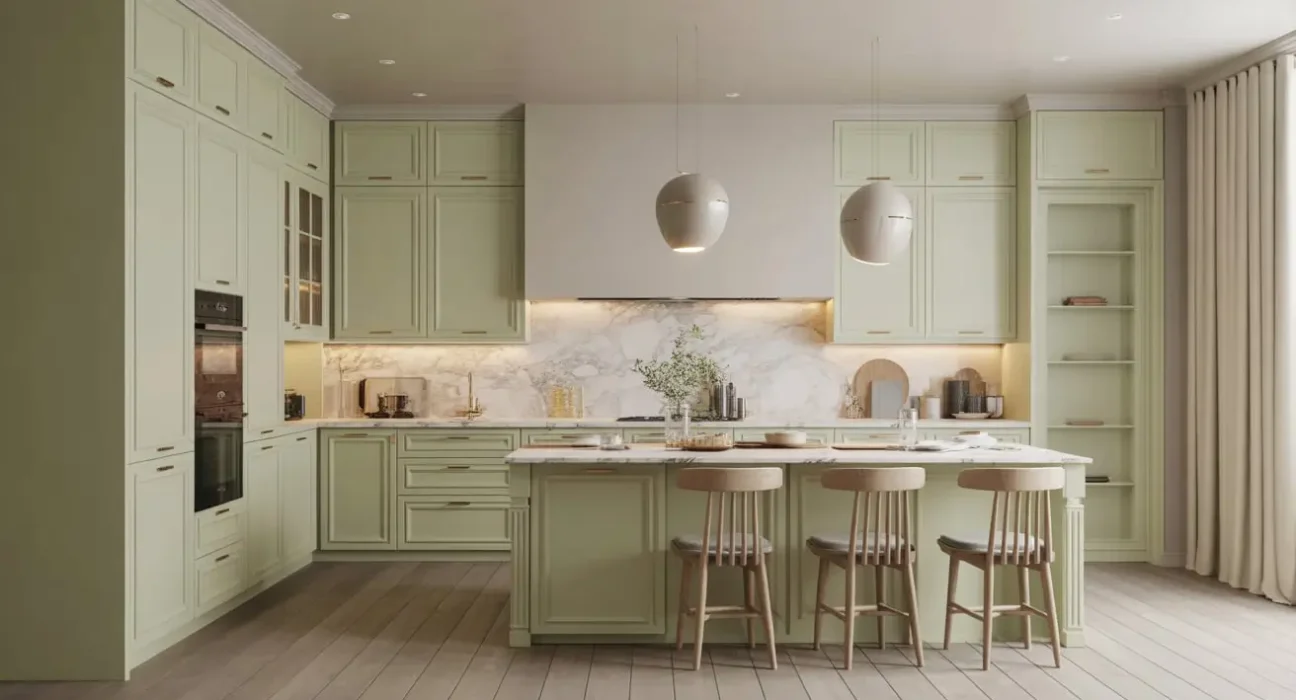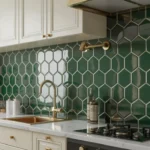Look, I get it. You’re tired of the same old white and gray kitchens flooding your Pinterest feed. You want something fresh, something that makes you smile when you walk in to make your morning coffee. Light green might just be the answer you’ve been hunting for.
I fell down the light green kitchen rabbit hole about a year ago when I was helping my sister redesign her kitchen. She wanted something cheerful but not overwhelming, sophisticated but not boring. Light green checked all those boxes—and honestly, I’ve been obsessed ever since. The color brings this incredible balance of calm and energy that you just don’t get from neutral tones.
Here’s the thing about light green: it’s having a serious moment right now, but it’s not trendy in that “everyone will hate this in two years” kind of way. We’re talking about a color that has staying power, versatility, and the ability to make your kitchen feel like an actual retreat instead of just a place where you burn toast.
Ready to see what light green can do for your kitchen? Let me walk you through 15 stunning ideas that’ll make you want to grab a paintbrush immediately.
1. Mint Green Shaker Cabinet Kitchen

Shaker cabinets are the little black dress of kitchen design—they work with everything. When you pair them with mint green, though? Chef’s kiss.
I love how mint green shaker cabinets bring this vintage-meets-modern vibe. The clean lines of the shaker style prevent the green from feeling too cutesy or cottage-like. You get that perfect balance between traditional craftsmanship and contemporary color choices.
The beauty of this combo is its flexibility. You can lean into a more traditional look with darker countertops and classic hardware, or you can go super modern with white quartz and sleek stainless steel fixtures. I’ve seen this work in cramped city apartments and sprawling suburban homes alike.
Pro tip: Keep the walls neutral (think soft white or light gray) to let those mint cabinets really pop. You want them to be the star of the show, not fighting with busy wallpaper or bold paint colors.
2. Light Sage and White Marble Kitchen
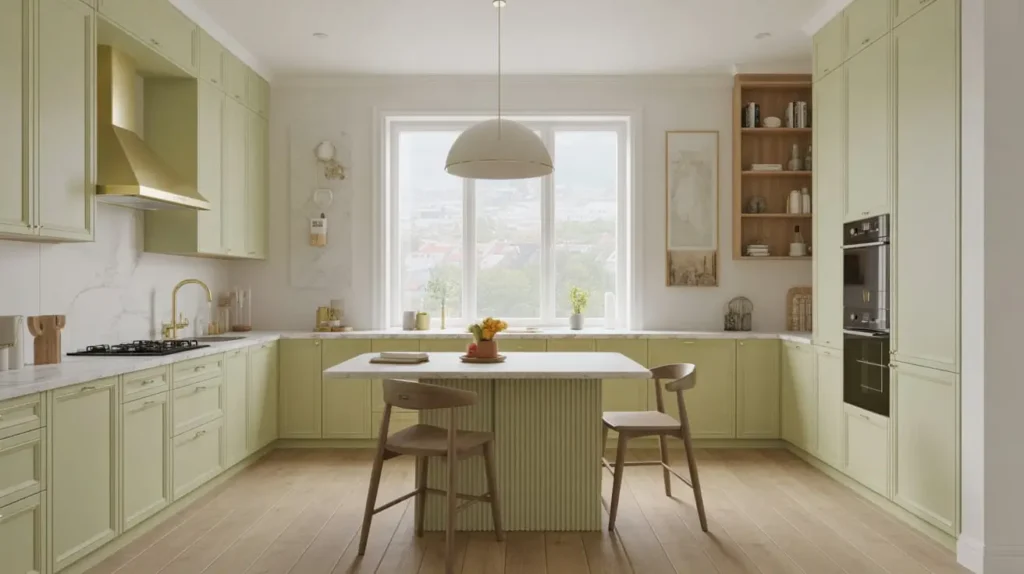
Can we talk about how elegant this combination is? Light sage green paired with white marble creates this sophisticated, almost spa-like atmosphere that makes you feel like you’re cooking in a boutique hotel.
Sage is softer and more muted than mint, which gives it a grown-up, refined quality. When you introduce white marble—whether on the countertops, backsplash, or even a kitchen island—you’re adding natural veining and texture that complements the organic feel of sage green.
I particularly love this look for open-concept spaces. The sage doesn’t scream for attention like bolder colors might, so it plays nicely with adjacent living areas. The marble brings just enough pattern and visual interest to keep things from feeling flat.
Here’s what works well with this pairing:
- Matte black fixtures for contrast
- Warm wood flooring to add coziness
- Simple open shelving to maintain the airy feel
- Pendant lights with clean lines to keep the modern aesthetic
3. Soft Green Coastal Farmhouse Kitchen

Ever wondered why coastal and farmhouse styles mesh so well? They both prioritize comfort, natural materials, and that lived-in feeling we all crave.
Adding soft green to this mix is like adding the perfect accessory to an already great outfit. Think pale seafoam or celery green—colors that remind you of beach glass and fresh herbs at the same time.
For this look, I’d go with painted cabinets in your soft green shade, paired with whitewashed wood elements. Maybe a reclaimed wood island or floating shelves made from weathered timber. Throw in some woven baskets, linen curtains, and ceramic dishware, and you’ve got yourself a kitchen that feels like a seaside cottage.
The key here is keeping everything feeling organic and a little imperfect. Farmhouse style isn’t about precision—it’s about warmth and character. Your soft green cabinets should have visible brushstrokes or a slightly distressed finish, not a glossy showroom sheen.
4. Pastel Green Scandinavian Minimalist Kitchen
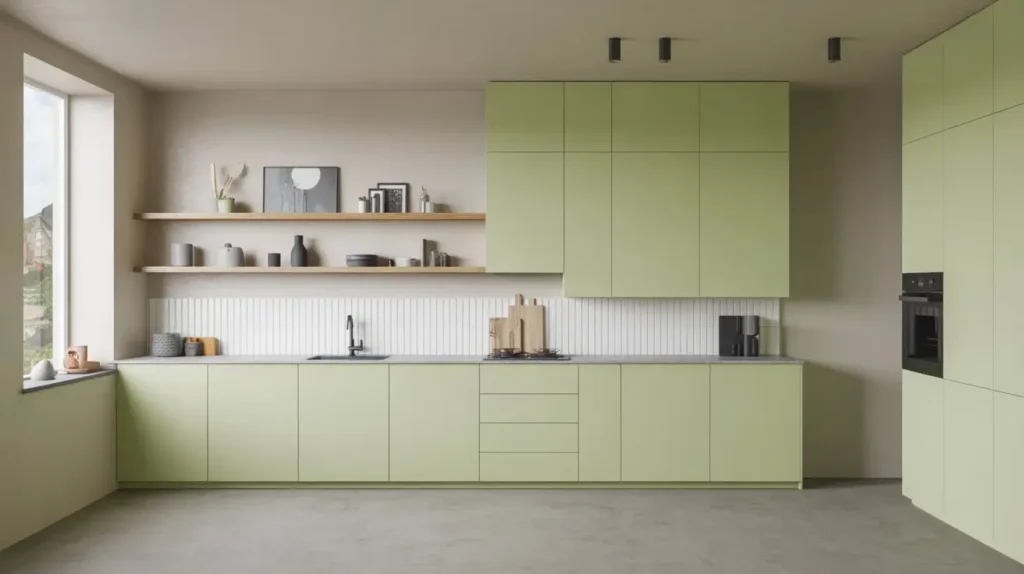
Scandinavian design gets a bad rap for being cold and sterile, but that’s usually because people forget the most important element: hygge. That Danish concept of coziness and contentment changes everything.
Pastel green in a Scandi kitchen brings warmth without cluttering the minimalist aesthetic. I’m talking about the palest green you can find—something that’s almost white but with just enough color to make your space feel intentional and curated.
This style works best when you commit to the “less is more” philosophy. You want:
- Flat-front cabinets with minimal hardware (or no hardware at all)
- Integrated appliances that disappear into the cabinetry
- A monochromatic color scheme with maybe one or two accent colors max
- Natural light flooding in through large windows
- Functional items displayed as decor (think wooden cutting boards and copper pots)
The pastel green should whisper, not shout. It’s there to add personality without disrupting the calm, organized vibe that makes Scandinavian kitchens so appealing.
Also Read: 15 Beautiful Green and White Kitchen Ideas with Cozy Vibes
5. Light Olive and Natural Wood Kitchen
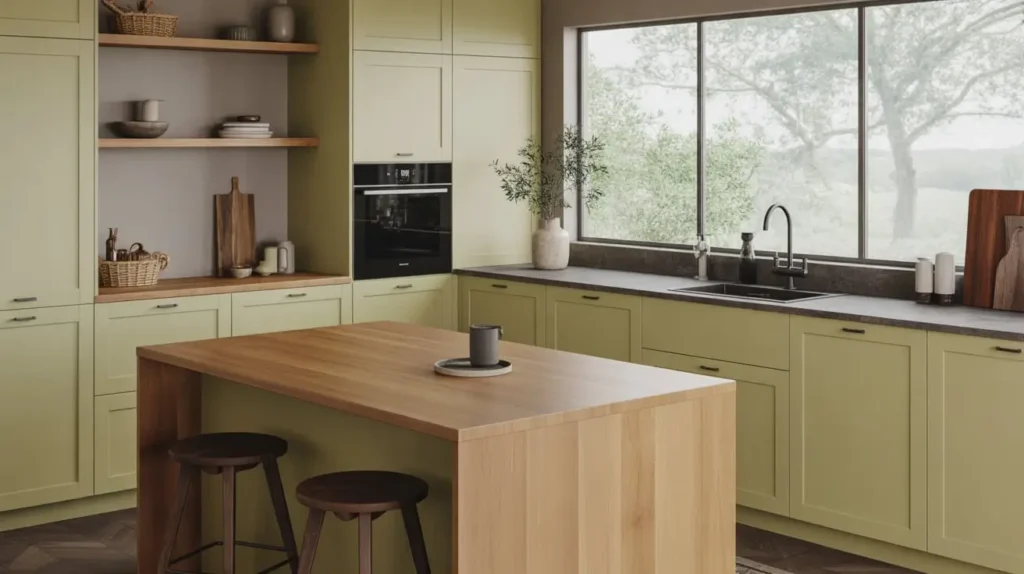
This combination speaks to my soul, honestly. Light olive green has this earthy, grounded quality that pairs beautifully with the warmth of natural wood.
I’m not talking about matchy-matchy here. You want variation in your wood tones—maybe oak floors, walnut countertops, and some lighter pine open shelving. The light olive acts as a bridge between all these different wood elements, creating cohesion without making everything feel too uniform.
What I love about olive is its chameleon-like quality. In bright morning light, it might look almost yellow-green and cheerful. In the evening with warm lighting, it takes on deeper, moodier tones. This shifting quality keeps your kitchen interesting throughout the day.
Consider these natural wood elements:
- Butcher block countertops or a wood island top
- Exposed wood beam ceilings
- Hardwood or engineered wood flooring
- Natural wood bar stools or dining chairs
Balance the warmth with some cooler elements like stainless steel appliances or matte black fixtures to prevent the space from feeling too heavy or monochromatic.
6. Mint Green Cabinets with Brass Accents
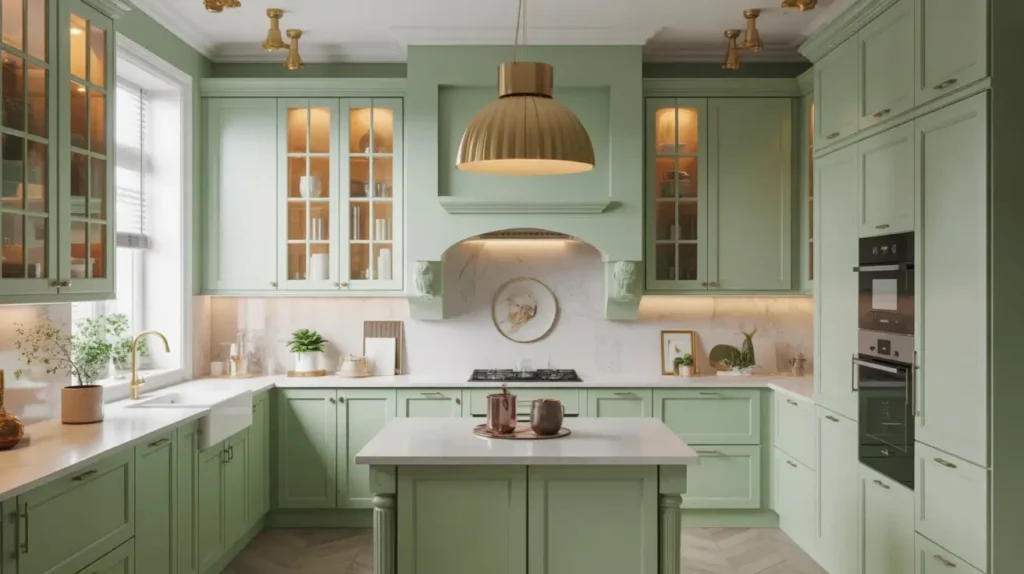
FYI, this combo is pure magic. There’s something about mint green and brass together that feels both vintage and totally current at the same time.
Brass brings warmth and a touch of glamour without the “look at me” vibe of gold. It’s more subtle, more lived-in looking—especially if you choose unlacquered brass that develops a patina over time. Against mint green cabinets, those brass accents create focal points that draw the eye.
I’d use brass for:
- Cabinet hardware (pulls and knobs)
- Faucet and sink fixtures
- Light fixtures (pendant lights over an island are perfect)
- Open shelving brackets
- Decorative elements like pot racks or utensil holders
The trick is not overdoing it. You want brass to accent the mint, not compete with it. Think of it like jewelry—a few well-chosen pieces make more impact than wearing everything at once.
Keep the rest of your palette simple. White countertops, neutral backsplash, maybe some warm wood tones. Let that mint-and-brass combination be the showstopper.
7. Soft Green Subway Tile Backsplash Kitchen

Okay, I know subway tile might seem basic at this point—it’s been everywhere for like a decade. But hear me out: soft green subway tiles completely change the game.
Instead of the standard white subway tile everyone and their grandmother has, you get the classic pattern with an unexpected color twist. The familiar shape keeps things grounded and traditional, while the soft green adds personality and freshness.
This works particularly well if you’re not ready to commit to green cabinets. You can keep your cabinets white, gray, or even wood-toned, and let the backsplash do the talking. It’s a lower-commitment way to introduce light green into your kitchen.
I’ve seen this done beautifully in a few different ways:
- All green subway tiles in a standard brick pattern
- Green and white tiles mixed in a checkerboard or random pattern
- Green tiles with darker green grout for definition
- Vertical stacking instead of the traditional horizontal layout for a modern twist
Pair this with white or cream cabinets, marble or white quartz countertops, and simple hardware. The backsplash becomes your focal point without overwhelming the space.
8. Pale Green Modern Cottage Kitchen
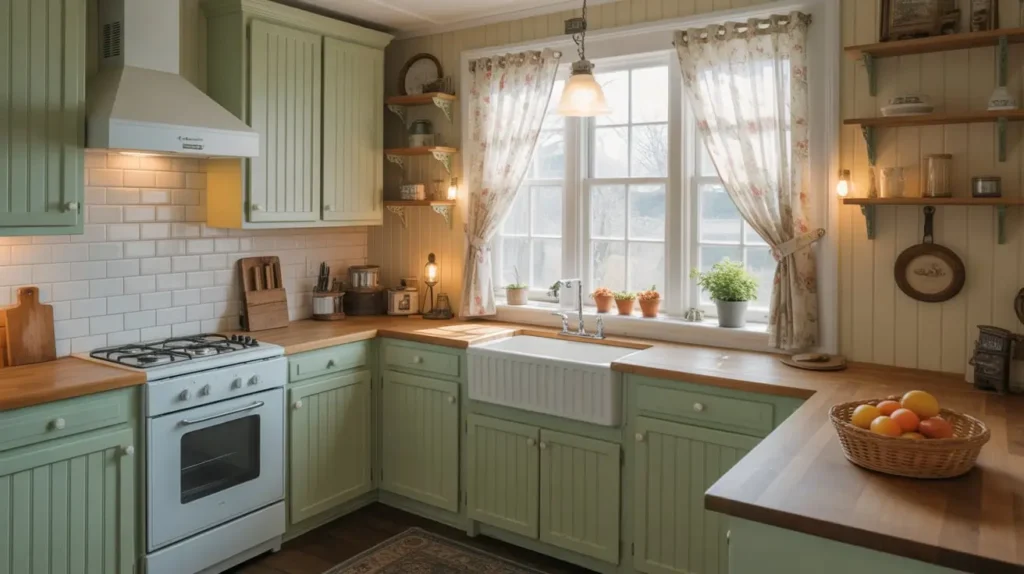
The modern cottage style is where I’d live if I could design my dream kitchen. It’s cozy without being cluttered, charming without being kitschy. Pale green fits this aesthetic perfectly.
Think of colors like celadon or the palest mint—barely-there greens that add color without drama. In a modern cottage kitchen, you want elements that feel collected over time, not bought all at once from a big-box store.
The “modern” part comes from keeping things clean-lined and functional. The “cottage” part comes from:
- Open shelving displaying dishes and glassware
- A farmhouse sink (preferably fireclay in white)
- Glass-front upper cabinets showing off pretty dishware
- Vintage-inspired lighting like schoolhouse pendants
- Personal touches like cookbooks, plants, and collected treasures
Your pale green cabinets should have a painted finish that looks hand-done, not factory-perfect. Some distressing at the edges? Even better. This style celebrates imperfection and character.
9. Light Green Two-Tone Cabinet Kitchen
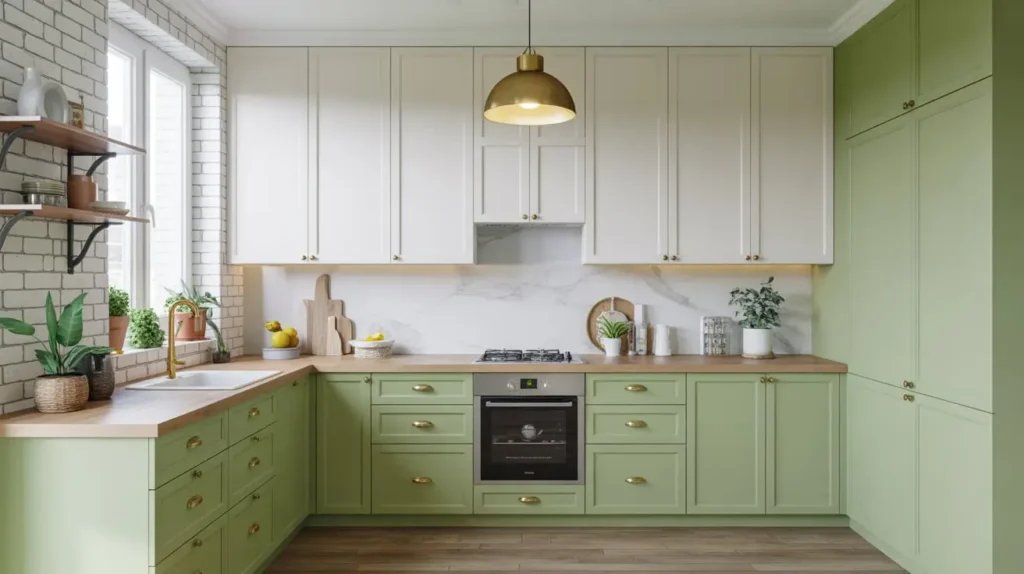
Two-tone kitchens have been trending for a while now, and for good reason—they add visual interest and help define different zones in your kitchen.
Using light green as one of your two tones gives you the best of both worlds. You get the freshness of color without committing every surface to it.
The most popular approach I’ve seen (and honestly, my favorite) is light green lower cabinets with white upper cabinets. This grounds the kitchen with color while keeping the upper portion light and airy. It also makes the ceiling feel higher, which is always a win in my book.
Another option? Light green island with white perimeter cabinets. This makes your island the focal point and gives you flexibility to change things up down the road without repainting your entire kitchen.
Things to keep in mind:
- Choose colors with similar undertones (both warm or both cool)
- Use the same hardware throughout for cohesion
- Keep countertops and backsplash neutral to let the cabinet colors shine
- Make sure you have enough of the green to make an impact—a tiny green island in a massive white kitchen might look like an afterthought
Also Read : 15 Trendy Green and Wood Kitchen Ideas for Modern Homes
10. Mint and Cream Retro-Inspired Kitchen
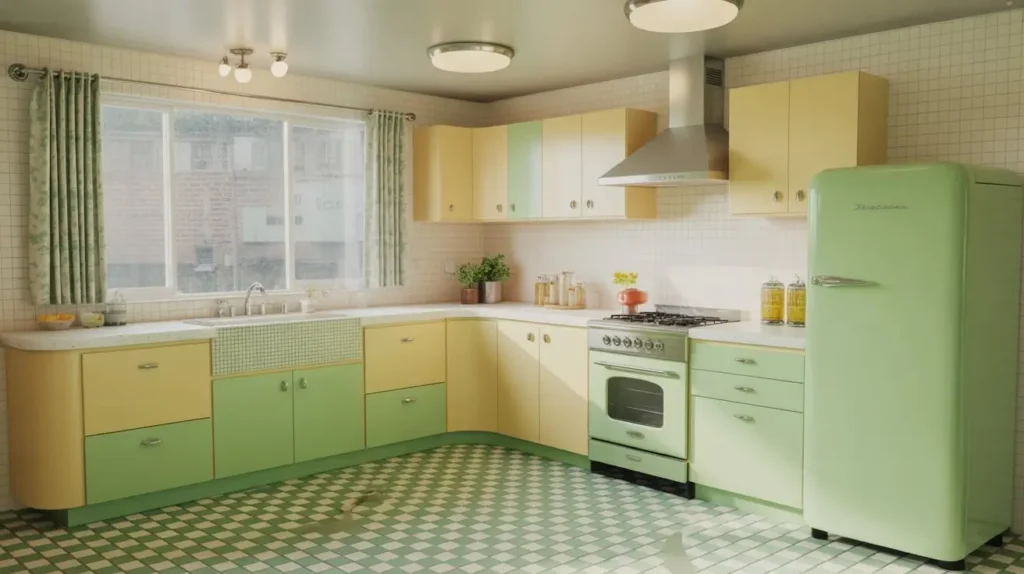
Confession time: I’m a sucker for vintage aesthetics. There’s something about mid-century design that just makes me happy. 🙂
A mint and cream retro kitchen takes you straight back to the 1950s, but in the best possible way. Think pastel colors, curved edges, chrome accents, and cheerful patterns.
For this look, you want:
- Mint cabinets with chrome handles (those vintage-style pulls with the curved design)
- Cream-colored appliances (yes, they make retro-style fridges and ranges that are fully modern inside)
- Checkerboard flooring in mint and cream or black and white
- Curved edges on your island or peninsula
- Vintage-inspired bar stools with chrome bases and vinyl seats
- Open shelving with plate rails to display colorful dishware
The beauty of retro style is that it’s inherently playful. You can have fun with it—add some kitschy salt and pepper shakers, display vintage Pyrex in your open shelves, hang retro-style ads or signs.
This isn’t a style for minimalists, but if you love color, pattern, and personality, a mint and cream retro kitchen might be your perfect match.
11. Light Green Kitchen with Open Shelving
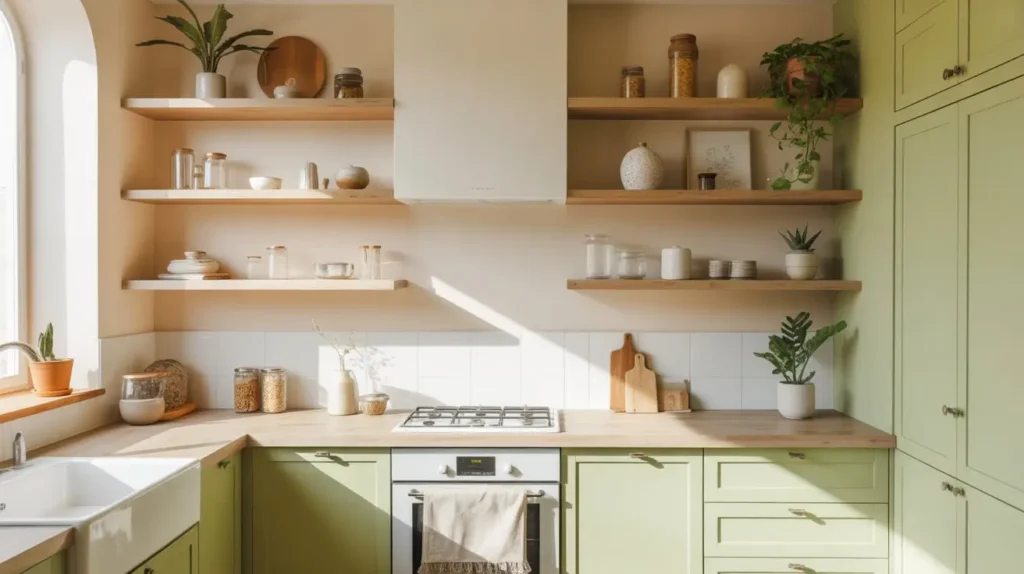
Open shelving isn’t for everyone—I’ll admit that right up front. If you’re someone who wants to hide the clutter, glass-front cabinets might be a better choice. But if you’re organized (or willing to become organized), open shelving in a light green kitchen creates such an airy, approachable vibe.
The light green cabinets provide color and visual weight on the lower portion of your kitchen, while the open shelves keep the upper walls feeling light and open. It’s a great solution for smaller kitchens that might feel cramped with upper cabinets.
Here’s what I’ve learned about making open shelving work:
- Keep items cohesive: stick to a color palette for your dishware and glassware
- Use baskets or containers for smaller items that might look messy
- Display items you actually use so the shelves don’t become dust collectors
- Mix functional and decorative pieces for interest
- Install good lighting above or under shelves to showcase your displays
The key is curation. You’re essentially creating a display every single day, so choose items that look good together and that you don’t mind being on show 24/7.
IMO, the best open shelving setups include a mix of everyday dishes, a few special pieces, fresh herbs or small plants, and maybe some cookbooks or decorative objects.
12. Pistachio Green and White Quartz Kitchen
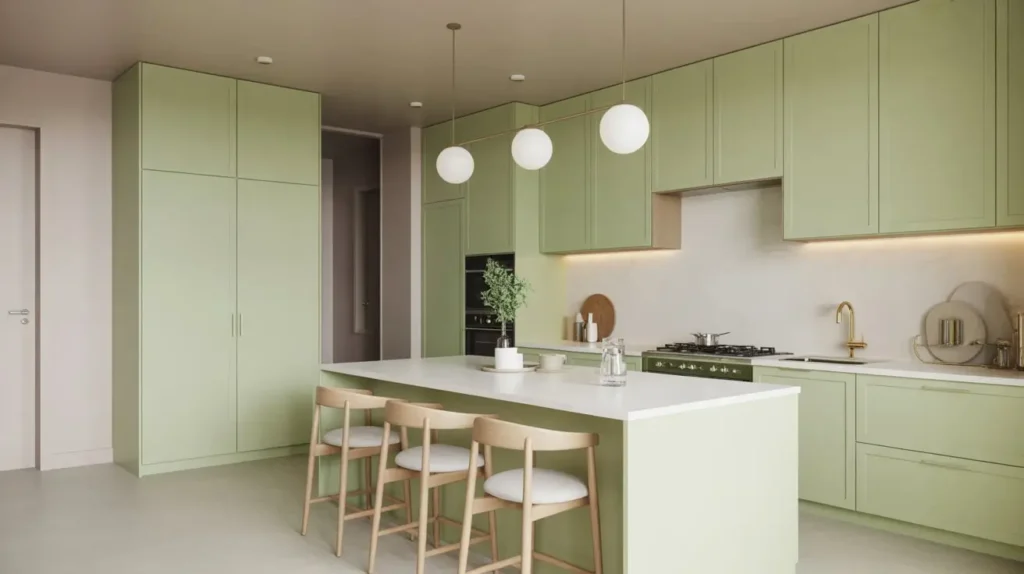
Pistachio green is slightly more saturated than some of the paler greens we’ve discussed, but it’s still soft and approachable. When you pair it with white quartz countertops, you create a clean, fresh look that feels both modern and timeless.
White quartz is pretty much the perfect countertop material—it’s durable, low-maintenance, non-porous, and comes in countless patterns. Against pistachio cabinets, it provides a crisp contrast that keeps the green from feeling muddy or dull.
I particularly love quartz options with subtle gray veining for this application. The veining adds just enough visual interest without competing with the cabinet color.
Why white quartz works so well here:
- Reflects light, making the kitchen feel brighter
- Provides a neutral backdrop for colorful dishes and decor
- Easy to clean (crucial in a kitchen)
- Won’t yellow or stain like some other materials
- Available in various edge profiles to match your style
Keep the backsplash simple—maybe white subway tile or even the same white quartz in a slab application. Let the pistachio cabinets and clean white quartz create a two-ingredient recipe that doesn’t need extra seasoning.
13. Soft Green Kitchen with Gold Hardware

While we talked about brass earlier, gold hardware brings a different energy entirely. Gold is warmer, more luxurious, and reads as decidedly more contemporary than brass.
Against soft green cabinets, gold hardware creates this sophisticated, upscale look that still feels welcoming. You’re not going for stuffy or formal here—just elevated and thoughtfully designed.
The gold I’m talking about isn’t your grandma’s shiny yellow gold. Modern gold finishes tend to be brushed or satin, giving them a more subtle, refined appearance. They catch the light beautifully without being too flashy.
Use gold for:
- Cabinet pulls and knobs
- Faucet and sink fixtures
- Light fixtures (especially statement pendants)
- Toe kicks or decorative trim elements
- Range hood accents
Pair this with white or light gray countertops, a simple backsplash, and you’ve got a kitchen that photographs like a magazine spread. Add some white marble, greenery in brass planters, and natural wood cutting boards, and you’re basically living in a design blog.
14. Light Green Island in All-White Kitchen
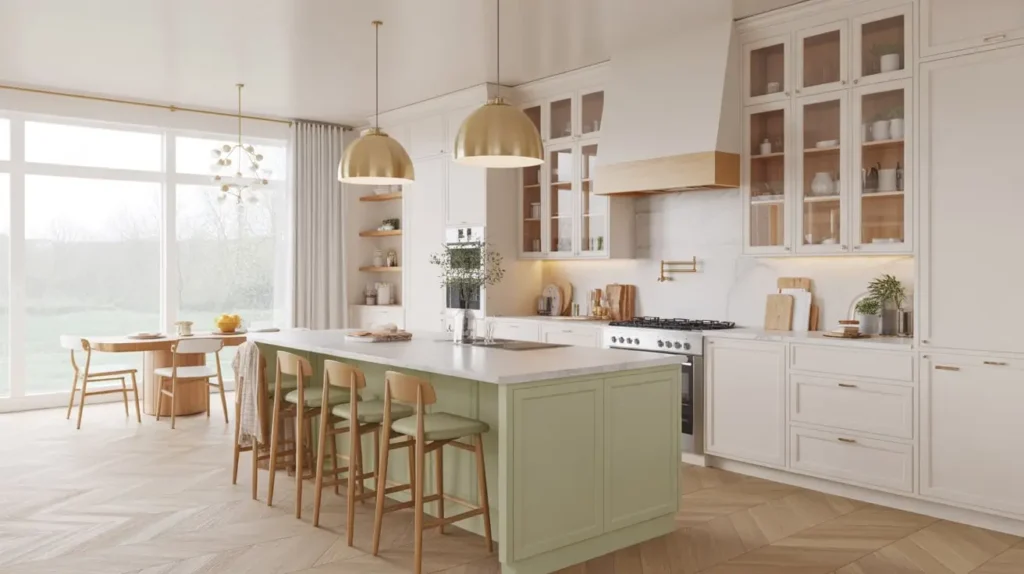
Sometimes you want just a hint of color—a taste, not a whole meal. A light green island in an otherwise all-white kitchen gives you exactly that.
This approach is perfect for people who love the idea of color but worry about commitment. Your island becomes the statement piece, the conversation starter, the element that elevates your kitchen from basic to special.
The all-white surrounding lets that green island really shine. It becomes a focal point naturally, especially if it’s in the center of your kitchen where everyone gathers.
Consider these island ideas:
- Different countertop material than the perimeter (like butcher block on the island vs. white quartz elsewhere)
- Open shelving or glass-front cabinets on the island to show off cookbooks or pretty dishware
- Seating on one or two sides for casual dining
- Different hardware than the white cabinets to further distinguish it
This setup also gives you flexibility. If you get tired of the green (though I can’t imagine why you would), you’re only repainting one element, not your entire kitchen.
Plus, psychologically, having that pop of color in the center of your kitchen creates energy and visual interest that an all-white kitchen sometimes lacks.
15. Sage Mist Kitchen with Woven Textures
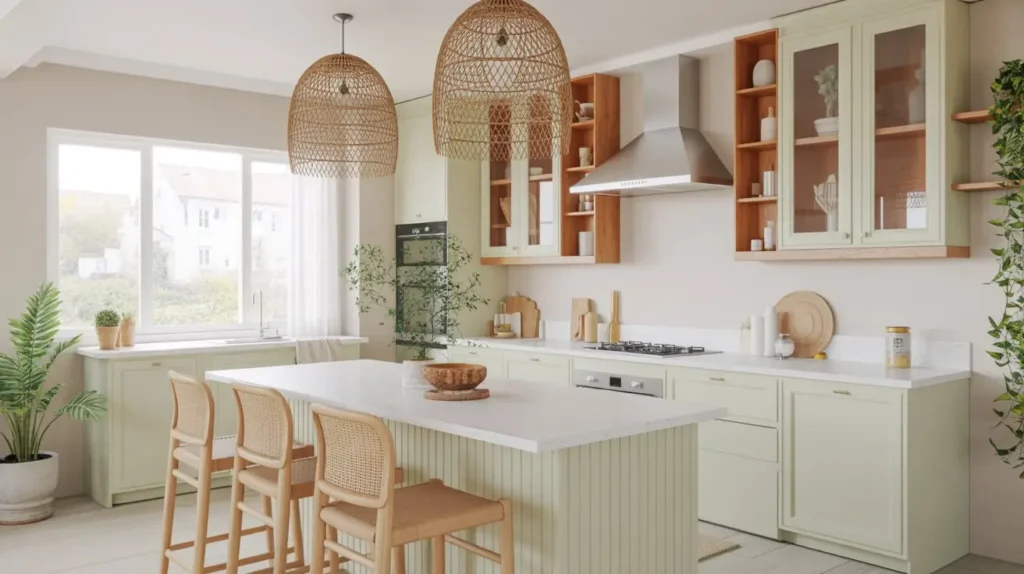
Let’s end with something really special. Sage mist is one of the most beautiful light green shades—it’s soft, complex, and changes with the light. When you combine it with woven textures, you create a kitchen that feels organic, tactile, and deeply calming.
Woven textures bring in natural materials that complement the earthy quality of sage mist. Think:
- Woven pendant lights (rattan, seagrass, or bamboo)
- Textured backsplash tiles with a woven or basket-weave pattern
- Natural fiber bar stools with woven seats
- Woven baskets for storage on open shelves
- Woven placemats and runners for your dining area
- Textured cabinet fronts if you’re feeling adventurous
This combination creates layers of visual interest without relying on bold colors or patterns. Everything feels cohesive and natural, like elements that belong together.
I love this look for kitchens that connect to outdoor spaces. The natural materials and soft sage color create a bridge between indoor and outdoor, making the transition feel seamless. Add some potted herbs on the windowsill, maybe some larger plants in corners, and you’ve created your own little oasis.
The key is varying your textures while keeping your color palette restrained. Lots of texture in similar neutral tones creates depth without chaos.
Making Your Light Green Kitchen Work
So you’re sold on light green (smart choice), but now what? Here are some practical tips I’ve gathered from way too many hours researching and from actual real-life experience helping friends and family with their kitchens.
Test your colors in your actual space. Light green can look completely different depending on your lighting, the direction your windows face, and your surrounding colors. Buy sample pots and paint large swatches on different walls. Live with them for a few days. Look at them in morning light, afternoon light, and evening artificial light.
Consider your home’s overall style. Light green is versatile, but make sure your kitchen won’t feel completely disconnected from the rest of your home. You want cohesion, not a jarring transition when you walk from your living room into your kitchen.
Think long-term. Color trends come and go, but will you still love this shade in five years? Ten? Light green has more staying power than, say, millennial pink, but it’s worth considering your own changing tastes.
Balance is everything. If you’re going with green cabinets, keep other elements more neutral. If you’re doing a green backsplash or just a green island, you have more flexibility elsewhere. The goal is for your kitchen to feel cohesive, not like a green explosion.
Final Thoughts
Here’s what I know for sure: light green kitchens bring joy. That might sound cheesy, but it’s true. There’s something about that fresh, natural color that makes cooking breakfast feel a little more special and washing dishes a little less terrible. :/
Whether you go full commitment with mint green shaker cabinets or you test the waters with a sage green island, you’re adding life and personality to a space that should feel welcoming and uniquely yours.
The best kitchen isn’t the one that looks perfect in a magazine—it’s the one that makes you happy every single time you walk into it. If light green does that for you, ignore anyone who says it’s too trendy or too bold or too anything. Your kitchen, your rules



